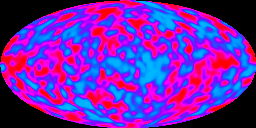Evidence ID: COS-EV14
Evidence: Great Galaxy Seeds
Summary: Scientists observed cosmic ripples - slight variations in temperature - that enabled matter over time to coalesce by gravitations attractions into galaxies. This coalescing of matter into galaxies is referred to as the Great Galaxy Seeds of the universe. This property of coalescence was so well regulated that it was not too great to ensure the universe did not collapse upon itself and not too small to ensure that matter in the universe did not become infinitely dispersed.
Description: Scientists observed that there was slight variation in the temperature of the Cosmic Microwave Background Radiation (CMBR) discovered by Penzias and Wilson. These temperature variations or cosmic ripples enabled matter to coalesce by gravitational attractions into galaxies over time.
This coalescing of matter into galaxies was observed by the NASA Cosmic Background Explorer (COBE) satellite in 1992. Two of COBE's principal investigators, George Smoot, and John Mather, received the Nobel Prize in Physics in 2006 for their discovery.
The COBE Differential Microwave Radiometers (DMR) experiment was designed to search for primeval fluctuations in the brightness of the CMBR representing small temperature differences between different parts of the sky.
The primeval fluctuations were observed to be extremely faint, only one part in 100,000. The fluctuations represent the varying densities of matter in the early universe. These densities were referred to as galaxy seeds.
These galaxy seeds are believed to have given rise to the structures that populate the universe today, specifically, clusters of galaxies and vast regions devoid of galaxies. This discovery was aptly coined the Great Galaxy Seeds of the universe.
These density ripples of matter from billions of years ago can be seen in the NASA image below.

Scientists also observed that the expansion of the universe was highly regulated causing matter to coalesce into galaxies. In fact, this property of coalescence was so well regulated that it was not too great to ensure the universe did not collapse upon itself, and not too small to ensure that matter in the universe did not become infinitely dispersed [COS-EV16].
From the COBE data we can readily observe that the densities of matter or forming galaxies of long ago are quite different from the galaxies we observe today. We can conclude that the structure of the universe has changed over time. This change in structure is further proof of our expanding, fine-tuned universe.
Resources:
Copyright@2025 Mainstream Apologetics